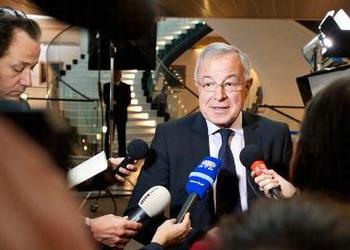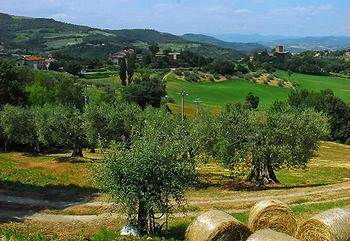Wow. The Europeans are getting it done where climate change is concerned. Twenty percent of the entire union's budget to cutting fossil fuel use is a serious commitment. In Europe, coal, oil, and nuclear are slated to be replaced by clean, sustainable sources of energy like wind, solar, geothermal, and hydropower.
Why don't we have the same commitment in the North America? Ask Exxon Mobil, and the other corporate giants in the business of selling coal and oil. They control America's energy policy. Until their money and influence are neutralized, where climate change is concerned, America will be a reluctant follower, not a leader.
__________________________
Europe Devotes 20 Percent of Budget to Climate Spending
The 20 percent commitment triples the current share and could yield as much as €180 billion in climate spending in all major EU policy areas over the seven-year period. (One euro equals US$1.34 at today’s rate of exchange.)
The EU’s development policy will contribute to achieving the 20 percent overall commitment, with an estimated €1.7 billion for climate spending in developing countries in 2014-2015 alone.

This is in addition to climate financing from the 28 individual EU member states.
After months of complex negotiations, agreement on this long-term financial framework marks a major step towards transforming Europe into a clean and competitive low carbon economy and helping developing countries adapt to the impacts of climate change, legislators said.
“We managed to get the priorities right,” said Alain Lamassoure of France, the current chairman of the European Parliament’s Committee on Budgets.
Speaking from the UN climate negotiations in Warsaw, Poland, EU Commissioner for Climate Action Connie Hedegaard said, “Today is an incredibly important day for Europe and for the fight against climate change. At least 20 percent of the entire EU budget for 2014-2020 will be climate-related spending. This is a major step forward for our efforts to handle the climate crisis.
“Rather than being parked in a corner of the EU budget, climate action will now be integrated into all the main spending areas,” said Hedegaard.
“This underscores yet again Europe’s leadership in the fight against this crucial challenge,” she said. “I believe the EU is the first region in the world to mainstream climate action into its whole budget.”
The budget for 2014-2020 allows the EU to invest up to €960 billion up to 2020.
Other instruments for unforeseen circumstances outside the budget represent an additional €36.8 billion, bringing the total commitments to €996.8 billion.
With this budget in place, climate action will be integrated into all the major EU policies.
Climate-relevant assistance to developing countries will have a renewed focus on low-carbon energy, food security, resilience and adaptation, with €1.7bn estimated in the next two years alone. This is on top of climate finance from individual EU member states.
Under the EU’s new Common Agricultural Policy, approved in Parliament on Wednesday, at least 30 percent of the rural development funds must be used for climate-related projects, creating opportunities for investments in climate-smart agriculture.
Under the new CAP, 30 percent of member states’ budgets for direct payments may be spent only if mandatory greening measures, such as crop diversification, maintaining permanent grassland and creating “ecologically-focused areas,” are carried out.
“The new CAP will strike a better balance between food security and environmental protection, better prepare farmers to face future challenges and be fairer and more legitimate,” said Agriculture Committee chair and lead negotiator Paolo De Castro of Italy, who represents the Progressive Alliance of Socialists and Democrats.
In the EU’s regional cohesion policy, earmarking for energy efficiency of 20 percent in the most developed regions and six percent for the less developed regions as well as for sustainable urban development is intended to ensure a strong focus on climate change action.
The research and innovation program, Horizon 2020, with an envelope of €63bn has a goal of 35 percent spending on research and innovation in energy, climate and clean technologies.
The new infrastructure instrument, called Connecting Europe Facility, will be climate friendly. It will fund transport infrastructure of €23bn and energy infrastructure of €5bn, mainly transmission grids for renewable energy.
Finally, the budget for the LIFE program, known as the EU’s Programme for the Environment and Climate Action, increases to over €3 billion, and a new subprogram for climate action receives a budget allocation of €760 million.
Year on year, the EU is building a pathway towards the US$100 billion goal in climate finance assistance to developing countries by 2020 agreed by governments under the 2009 Copenhagen Climate Accord.
As the world’s biggest provider of Official Development Assistance, the EU and Member States committed to provide €7.2 billion in ‘fast start’ finance for developing countries over 2010-2012 and exceeded this pledge by delivering a total of €7.34 billion, including €2.67 billion in 2012.
The European Commission channels EU adaptation funding via the EU Global Climate Change Alliance. From funding four pilot projects in 2008, the Alliance has grown to support more than 45 national and regional programs across 35 countries.
In 2013 the Commission committed €47 million for financing nine new projects in Chad, Comoros, Djibouti, Myanmar, Haiti, Malawi, Mauritania, Sao Tome e Principe and Tanzania.
The European Investment Bank, owned by the EU Member States, is one of the largest multilateral providers of climate finance among the international financial institutions. The EIB currently provides between €1.5bn and €2bn per year of climate finance for investments outside the EU.
The EU’s development policy will contribute to achieving the 20 percent overall commitment, with an estimated €1.7 billion for climate spending in developing countries in 2014-2015 alone.

Alain Lamassoure, chair of the European Parliament’s Budget Committee, speaks to media after the seven-year budget was approved, Nov. 19, 2013 (Photo courtesy European Parliament)
After months of complex negotiations, agreement on this long-term financial framework marks a major step towards transforming Europe into a clean and competitive low carbon economy and helping developing countries adapt to the impacts of climate change, legislators said.
“We managed to get the priorities right,” said Alain Lamassoure of France, the current chairman of the European Parliament’s Committee on Budgets.
Speaking from the UN climate negotiations in Warsaw, Poland, EU Commissioner for Climate Action Connie Hedegaard said, “Today is an incredibly important day for Europe and for the fight against climate change. At least 20 percent of the entire EU budget for 2014-2020 will be climate-related spending. This is a major step forward for our efforts to handle the climate crisis.
“Rather than being parked in a corner of the EU budget, climate action will now be integrated into all the main spending areas,” said Hedegaard.
“This underscores yet again Europe’s leadership in the fight against this crucial challenge,” she said. “I believe the EU is the first region in the world to mainstream climate action into its whole budget.”
The budget for 2014-2020 allows the EU to invest up to €960 billion up to 2020.
Other instruments for unforeseen circumstances outside the budget represent an additional €36.8 billion, bringing the total commitments to €996.8 billion.
With this budget in place, climate action will be integrated into all the major EU policies.
Climate-relevant assistance to developing countries will have a renewed focus on low-carbon energy, food security, resilience and adaptation, with €1.7bn estimated in the next two years alone. This is on top of climate finance from individual EU member states.
Under the EU’s new Common Agricultural Policy, approved in Parliament on Wednesday, at least 30 percent of the rural development funds must be used for climate-related projects, creating opportunities for investments in climate-smart agriculture.
Under the new CAP, 30 percent of member states’ budgets for direct payments may be spent only if mandatory greening measures, such as crop diversification, maintaining permanent grassland and creating “ecologically-focused areas,” are carried out.
“The new CAP will strike a better balance between food security and environmental protection, better prepare farmers to face future challenges and be fairer and more legitimate,” said Agriculture Committee chair and lead negotiator Paolo De Castro of Italy, who represents the Progressive Alliance of Socialists and Democrats.
In the EU’s regional cohesion policy, earmarking for energy efficiency of 20 percent in the most developed regions and six percent for the less developed regions as well as for sustainable urban development is intended to ensure a strong focus on climate change action.
The research and innovation program, Horizon 2020, with an envelope of €63bn has a goal of 35 percent spending on research and innovation in energy, climate and clean technologies.
The new infrastructure instrument, called Connecting Europe Facility, will be climate friendly. It will fund transport infrastructure of €23bn and energy infrastructure of €5bn, mainly transmission grids for renewable energy.
Finally, the budget for the LIFE program, known as the EU’s Programme for the Environment and Climate Action, increases to over €3 billion, and a new subprogram for climate action receives a budget allocation of €760 million.
Year on year, the EU is building a pathway towards the US$100 billion goal in climate finance assistance to developing countries by 2020 agreed by governments under the 2009 Copenhagen Climate Accord.
As the world’s biggest provider of Official Development Assistance, the EU and Member States committed to provide €7.2 billion in ‘fast start’ finance for developing countries over 2010-2012 and exceeded this pledge by delivering a total of €7.34 billion, including €2.67 billion in 2012.
Last year, at the UN climate negotiations in Doha, Qatar, the EU and member states announced voluntary contributions for developing countries of €5.5 billion, and the latest assessment shows they are on track to deliver this amount in 2013.
In 2013 the Commission committed €47 million for financing nine new projects in Chad, Comoros, Djibouti, Myanmar, Haiti, Malawi, Mauritania, Sao Tome e Principe and Tanzania.
The European Investment Bank, owned by the EU Member States, is one of the largest multilateral providers of climate finance among the international financial institutions. The EIB currently provides between €1.5bn and €2bn per year of climate finance for investments outside the EU.

No comments:
Post a Comment